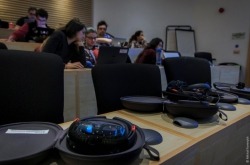About the program
I was one of the 25 summer school participants selected from 500 applicants from all over the world. Russia was represented by eight students altogether; three came from ITMO University (aside from Artyom, Department of Optical Physics and Modern Natural Science Master’s student Tatiana Kormilina and Department of Laser Technologies and Systems Master’s student Alexander Konovalov also made the cut), five others from St. Petersburg State University. The school was also attended by students from Mexico, Latvia, Slovenia, Slovakia, Spain, Italy, and the Netherlands. Although the program was only meant to last for four months, as early as during the application submission process each potential participant was asked whether they could stay in KAUST for a longer period of up to six months. I didn’t take this opportunity as I had to go back to Russia to continue my Master’s studies, but there were ones who decided to stay, including two other Russian students. KAUST is a very open university that puts in a great effort in attracting students to its PhD positions. Candidates wanting to join only had to prove their English language proficiency by passing an IELTS test and an interview.
Only students were eligible to apply for the KAUST Photonics summer school. My class included Master’s students and senior Bachelor’s students. What was so special about the school was that it was extremely valuable not only in terms of doing high-profile scientific research, but also in the funding it offered. Participants didn’t have to spend a penny; all costs were remunerated. All you had to do was to take your studies seriously and report on the work you accomplished.

The program coordinators did their best at making us as much informed as possible about the distinctive features of the place we found ourselves in. The first week of the school was spent on familiarizing us with the university staff and local laws, some of which were rather unusual. For example, we were surprised to learn that in Saudi Arabia it is forbidden to talk about religion, hostile neighboring states, alcohol, and lots of other topics. There were many organizational aspects we had to remember, but it wasn’t difficult as the program was exceedingly well-organized. During the second week, we were introduced to the six laboratories we’d be doing our work in, as well as to their staff. It was only after that the research really started.
About KAUST University
KAUST is not your typical national university; it is a world-class research center that draws on the impressive expertise brought in by leading international scientists. That’s why this summer school gave us a unique opportunity to meet international experts with a completely different approach to both scientific tasks and life in general. Founded in 2009, KAUST is a young university with the most state-of-the-art equipment out there. For instance, this summer school was my first encounter with the so-called ‘clean’ laboratories. These are special research spaces with controlled air ratios of such particles as dust, microorganisms, aerosols, and chemical vapors. Other factors like humidity, pressure, and temperature also can be modified. You have to wear a special gear to be allowed to enter this kind of labs as they’re used for conducting experiments that require a high level of purity. I did see these technologies back home in St. Petersburg, but at a much smaller scale.

Only a few of university staff are locals; the majority of researchers and lecturers come from all over the globe. Famous KAUST professors include prominent scientist Andrea Fratalocchi, who, by the way, is also a partner of ITMO University and works in close cooperation with Yuri Kivshar, co-head of ITMO’s International Research Center of Nanophotonics and Metamaterials and professor at the Australian National University.
Summer school research
Before arriving to KAUST, each participant has to choose a professor to work with. I chose Italian scientist Carlo Liberale as he was the only optics researcher on the list. Although my Master’s studies do not particularly focus on optics, My Bachelor’s degree was in optics, and I wanted to work with this sphere as part of the KAUST summer school. The program organizers suggested I look at it from the biological engineering perspective. I worked in a bioengineering laboratory specializing on Raman combinational scattering, which was especially valuable as this is my favorite research area that uses optical spheres for bioengineering uses.
The professor I opted for offered me several research topics to choose from. I decided to pursue a project aimed at improving temporal and sound equipment characteristics. The laboratory I worked in had special equipment for gaging the stimulated Raman scattering (SRS) spectrum, which, in its turn, gives information on molecular vibrations occurring within materials. Biologists use molecular vibrations for monitoring processes in bacteria, measuring their biological composition, and conducting imaging, which is creating images of objects through the SRS spectrums. It’s impossible to obtain these images via optical microscopes, but the SRS technologies produce high-contrast images that capture rapidly evolving processes which usual microscopes can’t even register. I worked on upgrading this equipment in order to speed up the imaging process. It took the initial set-up arrangements one millisecond to make one picture. I managed to increase the speed tenfold.

All participants were given different tasks: some did computer modelling, others conducted experiments, garnered and analyzed data. I wanted to use my KAUST summer school experience to work on nonlinear optics tasks.
About the laboratories
The work I did in KAUST laboratories wasn’t much different from what I was doing in Russia. What was new for me was the administrative part of it all. KAUST University attaches particular importance to making sure that every researcher knows safety rules. To get access to a laboratory, all of which are password-protected, you have to pass safety measures tests. I took five of these in total, each lasting for an hour, which basically means that I spent a whole day trying to get a lab pass. It may seem strange to us Russians, but the level of order and organization there is really impressive: each lab activity is governed by a rule that everyone obediently follows. That’s what makes working in KAUST laboratories so enjoyable.

Who should go to the summer school
Anyone and everyone. The KAUST Photonics summer camp is a great opportunity to work in one of the most modern laboratories to date; all you’re required to do is to try to put in your best effort for the work you’ve been assigned. What’s more, this summer school enables you to stay in KAUST should you want to.





